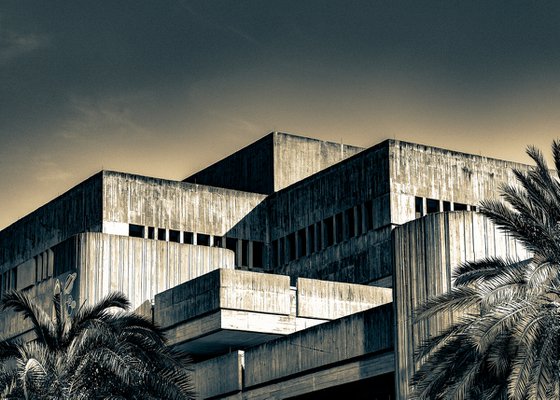- By medium
- By subject
- By budget
- Sales
- Gift cards
- Discover all art
- Artists
- Editors’ picks
- Ideas
Artwork description:
In 1962, the citizens of Orlando passed a Civic Improvements Bond issue that provided a million dollars to replace the Albertson Public Library, a Neoclassical-style structure that opened in 1923. For the new building, at the corner of Rosalind Avenue and Central Boulevard in downtown, the city selected the Connecticut-based architect John Johansen (1916-2012) to create a signature design that represented an expansive new era in Central Florida. Johansen was one of the “Harvard Five,” influential architects who studied with Walter Gropius, himself a pioneer in modernism and the founder of the Bauhaus, a significant design school in 1930s Germany._x000D_
_x000D_
Johansen specialized in Brutalism, a bold architectural concept featuring unfinished concrete for interior and exterior surfaces. The name originates from the French term beton brut, in a reference to the “raw” or unpainted nature of the concrete. A Brutalist building is basically constructed in the same way as a sandcastle, using rough wood boards as “formwork” to hold the poured concrete. When the material dries, the wood is removed, leaving patterns, striations, and markings of the organic material on the walls, stairways, and ceilings._x000D_
_x000D_
For the Orlando Public Library, Johansen conceived a series of concrete towers and boxes held in position at various heights by strong piers. The building featured rough-hewn cedar patterns embedded in its poured-concrete walls, surrounding an interior open space with a rooftop patio overlooking nearby Lake Eola. Martin Van Buren of North Carolina worked as interior design consultant, while local architect Robert Murphy coordinated the design and construction process with Johansen, who lived in New Canaan, Conn. (Murphy is perhaps best known for his firm’s 1963 concrete “Round Building,” which once stood on the grounds of what’s now the Dr. Phillips Center for the Performing Arts.) At the completion of the new library, director Clara Wendel lauded the building, noting that it “has had an emotional impact on the city unmatched by any structure in its history” (Library Journal, 1966).
Materials used:
Giclée print using pigment inks on Hahnemühle Baryta FB paper.
Tags:
#architecture #usa #brutalist-architecture #brutalism #orlando #vintage print #public libraryThe Public Library - Orlando (2018) Photograph
by Stephen Hodgetts Photography
14 Artist Reviews
£95
- Photograph on Paper
- From a limited edition of 25
- Size: 28.96 x 41.66cm (unframed) / 35 x 25cm (actual image size)
- Signed and numbered on the front
- Style: Photorealistic
- Subject: Architecture and cityscapes
Loading
Artwork description
In 1962, the citizens of Orlando passed a Civic Improvements Bond issue that provided a million dollars to replace the Albertson Public Library, a Neoclassical-style structure that opened in 1923. For the new building, at the corner of Rosalind Avenue and Central Boulevard in downtown, the city selected the Connecticut-based architect John Johansen (1916-2012) to create a signature design that represented an expansive new era in Central Florida. Johansen was one of the “Harvard Five,” influential architects who studied with Walter Gropius, himself a pioneer in modernism and the founder of the Bauhaus, a significant design school in 1930s Germany._x000D_
_x000D_
Johansen specialized in Brutalism, a bold architectural concept featuring unfinished concrete for interior and exterior surfaces. The name originates from the French term beton brut, in a reference to the “raw” or unpainted nature of the concrete. A Brutalist building is basically constructed in the same way as a sandcastle, using rough wood boards as “formwork” to hold the poured concrete. When the material dries, the wood is removed, leaving patterns, striations, and markings of the organic material on the walls, stairways, and ceilings._x000D_
_x000D_
For the Orlando Public Library, Johansen conceived a series of concrete towers and boxes held in position at various heights by strong piers. The building featured rough-hewn cedar patterns embedded in its poured-concrete walls, surrounding an interior open space with a rooftop patio overlooking nearby Lake Eola. Martin Van Buren of North Carolina worked as interior design consultant, while local architect Robert Murphy coordinated the design and construction process with Johansen, who lived in New Canaan, Conn. (Murphy is perhaps best known for his firm’s 1963 concrete “Round Building,” which once stood on the grounds of what’s now the Dr. Phillips Center for the Performing Arts.) At the completion of the new library, director Clara Wendel lauded the building, noting that it “has had an emotional impact on the city unmatched by any structure in its history” (Library Journal, 1966).
Materials used:
Giclée print using pigment inks on Hahnemühle Baryta FB paper.
Tags:
#architecture #usa #brutalist-architecture #brutalism #orlando #vintage print #public library14 day money back guaranteeLearn more


